Measuring atmospheric $CO_2$
Goals:
- Examine recent data on $CO_2$ levels in the atmosphere, and how they have been changing.
- Question how to measure levels "in the atmosphere"!
- Find out how we know about $CO_2$ levels in the past (before we had instruments to measure it).
- Raise the puzzle about long ago levels: Much higher than now, so why should we care?
Charles Keeling
...Heard about Arrhenius' work, and wondered how levels had changed since then. He developed an instrument to measure carbon dioxide in Earths atmosphere as a graduate student. He used it in the mid-1950s and found:
- Carbon-dioxide levels were above those measured in the 19th century--Pre-industrial levels are now thought to have been about 280 ppm.
- There was a strong seasonal variation in these levels.
He finished his PhD, but thought it would be interesting to keep track of $CO_2$ a little longer. But where to go for the best measurement??
If you want to get an idea of worldwide concentrations of $CO_2$ over long periods of time... is a city a good place to build a place to measure $CO_2$ concentrations in the atmosphere?
The Mauna Loa observatory is located on an extinct volcano on one of the Hawaian islands, in the middle of the Pacific Ocean.
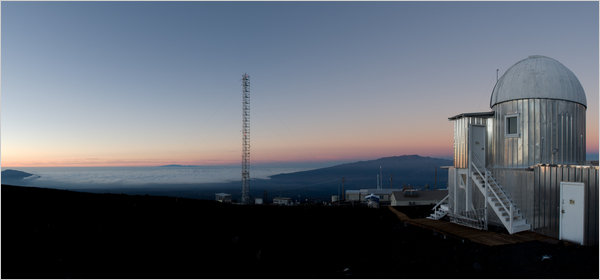
Scientists, starting with Keeling have been making measurements of $CO_2$ since the 1950s:
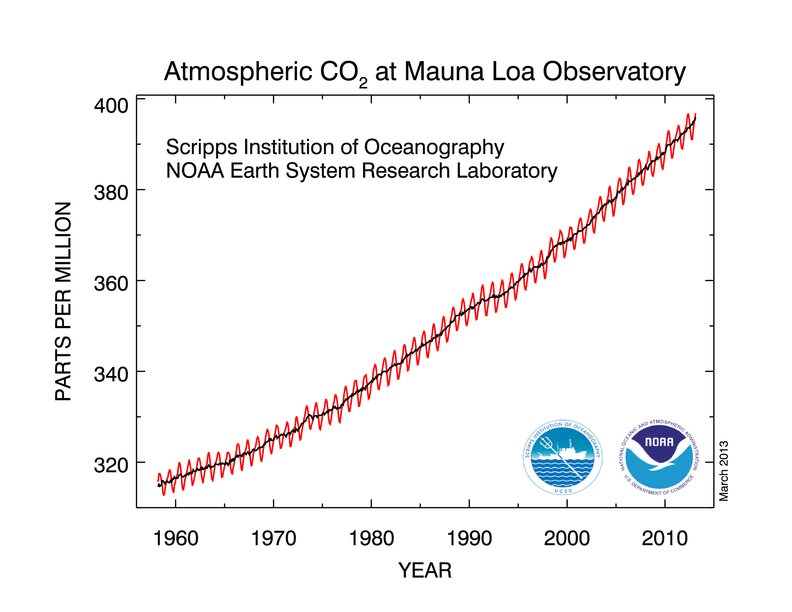
The goal of environmental advocacy group 350.org is to get this graph down to 350 ppm once more. A key member of this coalition, Bill McKibben visited Goshen College in 2009.
Exxon used its fleet of tankers (travelling all over the world's oceans) to sample $CO_2$ worldwide (late 70s), and also concluded it was rising.
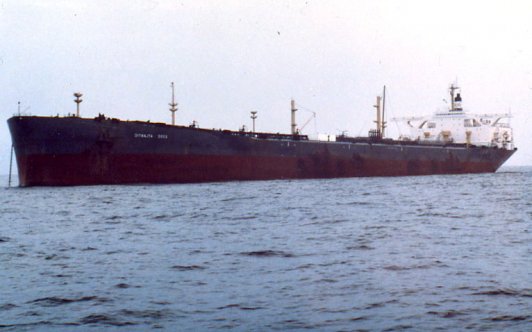
Seasonality of the Keeling Curve
Here are two recent years of $CO_2$ meaurements at Mauna Loa:
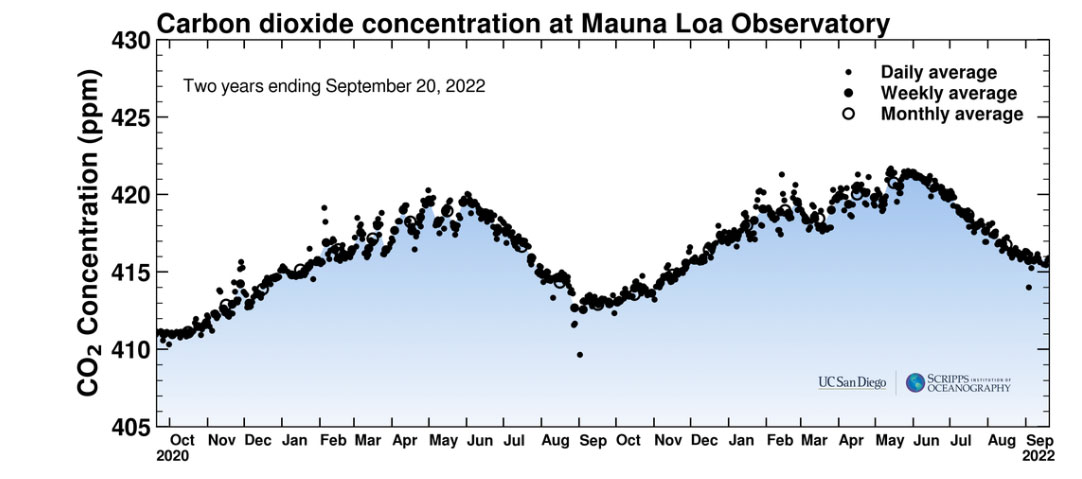
keelingcurve.ucsd.edu
It seems like the $CO_2$ levels are varying annually. Every year, during summer in the northern hemisphere, $CO_2$ levels are dropping. Can you make any educated guesses about why??
- Trees (and all other vegetation) is growing the most, making new leaves, another tree ring, growing taller during summer months
- We know that vegetation gets the carbon it needs to make its tissues from the atmospheric $CO_2$. Maybe this is enough to temporarily reduce the $CO_2$ levels?
- But why should the northern hemisphere dominate over the southern hemisphere? During our winter, it's summer in the southern hemisphere. Wouldn't they balance each other out?
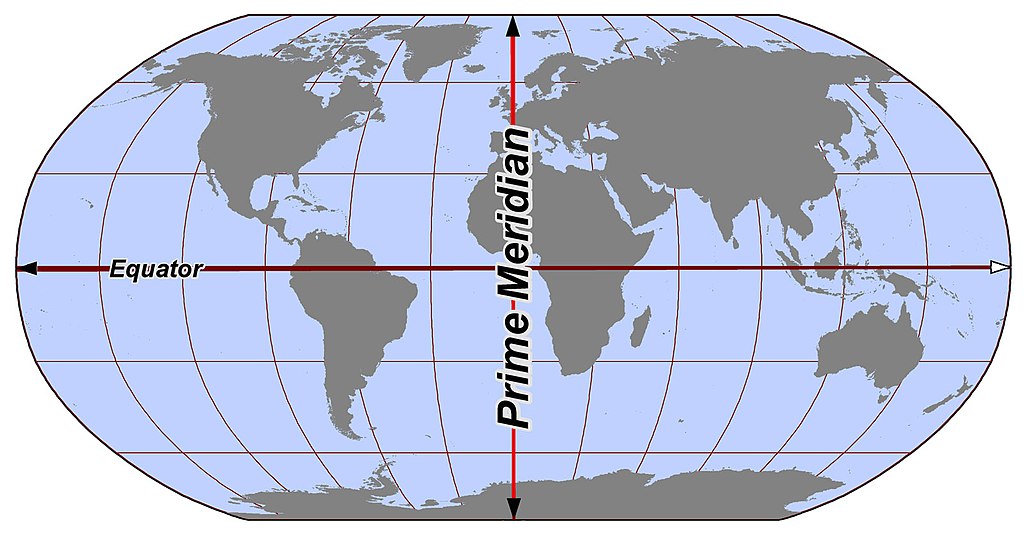
It turns out there's about twice as much land north of the equator as south...
How long has $CO_2$ been increasing?
How do we know atmosphere composition and temperature in the distant past?
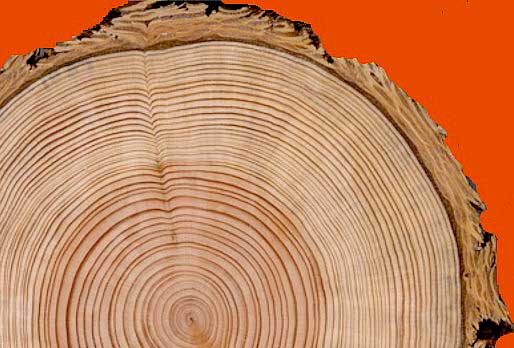 Tree
rings (thickness and density) depend on temperature. We can go back ~11,000 yr.
(Temperatures) "dendrochronology"
Tree
rings (thickness and density) depend on temperature. We can go back ~11,000 yr.
(Temperatures) "dendrochronology"
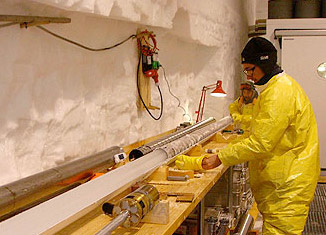 Ice cores preserve air samples back about 650,000 yr. When melted, the CO2 that comes out of the ice can be measured, as a function of depth below the surface.
Ice cores preserve air samples back about 650,000 yr. When melted, the CO2 that comes out of the ice can be measured, as a function of depth below the surface.
Temperature affects the ratio of O16 to O18. Oxygen isotope ratios in calcite (shells) ($\text{CaCO}_3$) can be used to deduce temperatures (Temperatures)
Carbon-dioxide levels
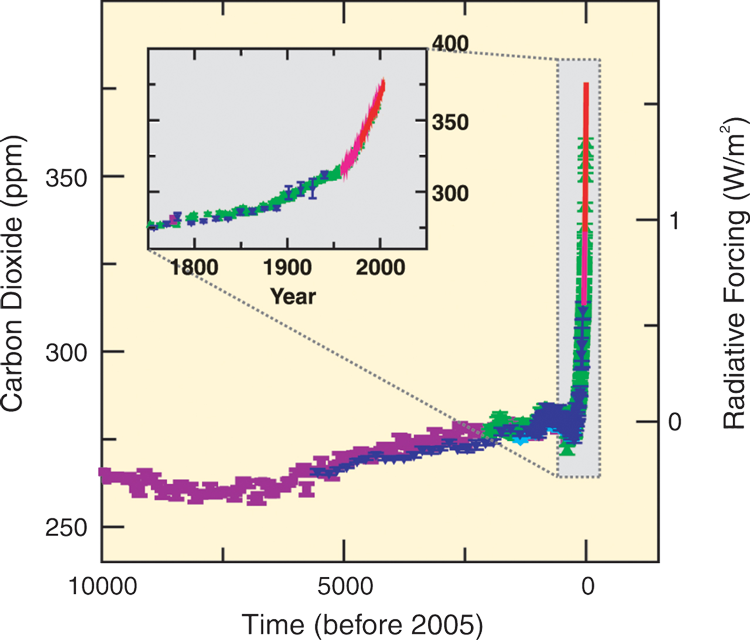
What happened around 1800?
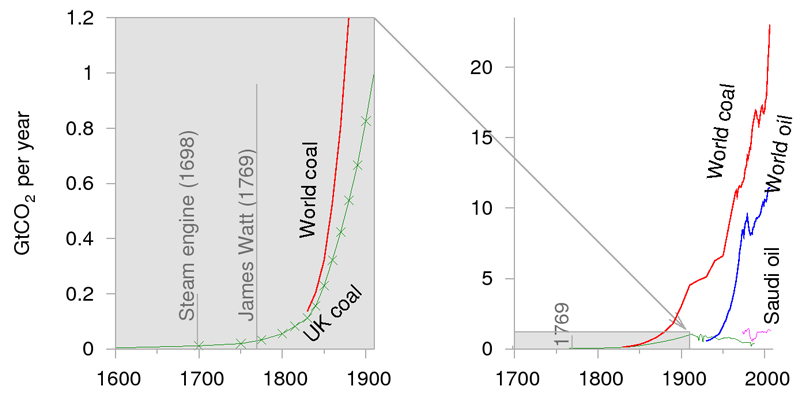
(MacKay)
Humans? One thing we did starting with the industrial revolution was to burn coal to power machines. Coal is almost pure carbon, so when we burn it, the chemical reaction is: $$C+O_2\to CO_2 + \text{heat}.$$
Really long-term carbon-dioxide levels
(Berner, Science, 1997):
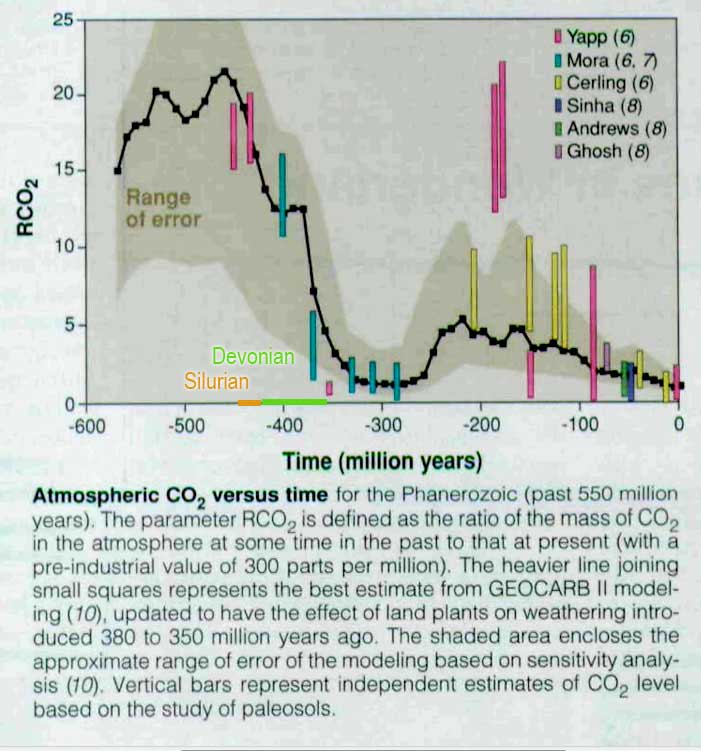
"$RCO_2$" is the ratio of $CO_2$ in the atmosphere to what we have today. For example $RCO_2=10$ means 10 times the current amount of $CO_2$.
[Where trees get their mass from has a clue about what was happening in this graph.]
doesn't come out of the soil -->
- Meaured the amount of soil in [a] pot very carefully.
- Planted a tree in the soil and took care of it for 5 years making sure no soil left or was added to the pot
- After 5 years, he widhed the tree and soil The tree was 72 kg [that's 72,000 grams] but the mass of the soil had only decreased by 60 g.
[His conclusion] was that trees don't get their weight from soil, but his experiment did not tell him where exactly it does come from. He ended up inferring that the weight came from water. In reality, trees get their mass from carbon dioxide...
- Silurian - small land-based mossy plants and vascular plants
- Devonian - Free sporing vascular land plants spread on land, forming vast forests.
Search the web for answers:
- Paleoclimatologists tell us that over the course of the entire geological history of Earth. it has switched between two states "Greenhouse Earth" and "Icehouse Earth". What defines which state we're in?
- Which state are we in right now?
- Overall, how much time (or what percentage of our history) has Earth spent in "Icehouse" state and in "Greenhouse" state?
How has temperature been changing?
And how fast?
Xkcd's temperature change graph
and
the 2017 WMO report on Greenhouse Gases
...both make the point that the recent rate of change of $CO_2$ is so much faster than changes during Earth's pre-industrial natural history.
A study of yeast (Bell and Gonzalez, Science 2011) found that these organisms could change their tolerance of (initially) near-lethal salt concentrations in the course of 50-100 generations. It's a leap to generalize this to animals. And the populations dropped at first before enough "mutants" survived for population increase.
Image credits
Henri Grissino-Mayer Hannes Grobe/AWI, redrawn, supplemented and modified graphic from John S. Schlee (2000) Our changing continent, United States Geological Survey., CC BY 2.5